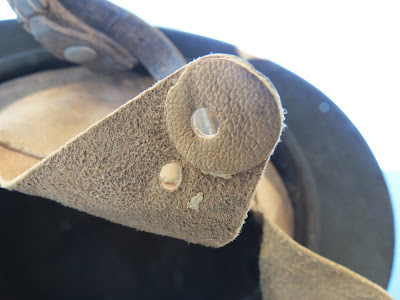It's June 28, 1914 and 19-year-old Serbian Gavrilo Princip made history. And how.
By killing one of Europe's most insignificant monarchs, Princip plunged the world into a war that cost thirty-eight million casualties including 25% of the Serbian army.
I bet he didn't see that one coming.
The Serb forces were depleted after the Balkan wars and were sorely under-manned and under-equipped at the outset of the Great War. Overwhelmed by the Bulgarians, Serb forces were nearly devoured and had to flee into neighboring Albania.
Enormous amounts of Serbian military materiel were captured by the Bulgarians, including French-made Serbian m.1915 helmets. Those helmets would embark on a long journey which would see them converted into Bulgarian air-defense helmets during World War Two and , eventually, to my helmet gallery.
What keeps this from being a typical French-produced m.1915 Adrian helmet is the addition of the additional split pins and rivets.
In the newer layer of paint is the outline of the original Serbian helmet insignia.
The crest, one of the features that is emblematic of an Adrian, is more than just decorative...
it provides an air-flow through the helmet to provide ventilation and a modicum of comfort for the wearer. Air enters the slits on each side of the crest...
and exits through this hole in the crown of the shell.
The rivets at the top attest to the variety of liners that this helmet has had.
The original WWI liner brackets, as with all Adrians, were welded to the shell, the evidence of the welds are clearly visible. At some point in the history of this helmet what I imagine were similar brackets were riveted in place of the earlier welded ones.
The large split-pins affix the final liner in this helmet - a WWII Bulgarian, when this helmet was reconditioned with new liner. new paint, and a new mission - wartime civil defense.
The smaller split-pins affix the leather to the band, and the larger pins, the band to the shell.
The band was originally finished bright, very little of which remains intact.
The liner is the type found in the Bulgarian m.36/C of the Second World War. The chinstrap bears a great similarity to that found in German helmets of WWII, of whom
Bulgaria was an ally.
The liner is of fairly good quality, with the drawstring holes backed by
leather washers.
The sole marking on this helmet is the ink-stamped liner size on the inside of the liner.
And here are some views of the Serbian m.1915 in WWI service.
And what happened to Gavrilo Princip? he's considered a hero in modern-day Serbia.
It's a heart-warming story of "local boy makes good". All's well that ends well, I guess
See you next time with another cool helmet from the collection.
Mannie





























